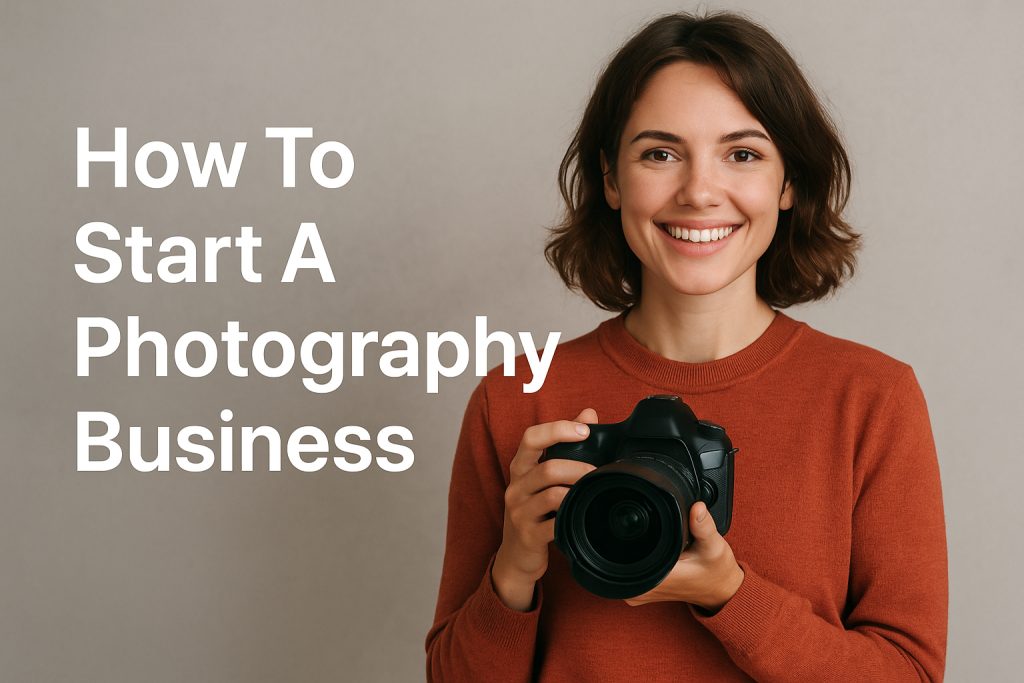Transforming your love for capturing moments into a sustainable career takes more than technical skill. Many creatives feel excited yet unprepared when navigating licenses, taxes, and client management. Balancing artistic passion with practical business strategies separates hobbyists from professionals.
Equipment expenses often intimidate newcomers, but smart budgeting makes quality gear accessible. Second-hand cameras or rental options help manage initial costs. Focus first on mastering your craft—clients value unique perspectives more than expensive gadgets.
Legal foundations matter from day one. Choosing the right business structure protects personal assets while maximizing tax benefits. Contracts, insurance, and clear pricing models build trust with customers and prevent disputes.
This guide simplifies complex processes into clear milestones. You’ll learn to identify profitable niches, create service packages clients want, and market your work effectively. We’ll share insider tips on avoiding overspending and establishing workflows that support growth.
Key Takeaways
- Strategic planning balances creative goals with financial stability
- Legal compliance prevents costly errors down the road
- Equipment investments should match current service offerings
- Niche specialization increases marketability
- Client relationships drive repeat business and referrals
Building a photo venture requires patience, but each step brings you closer to doing what you love full-time. Let’s create a roadmap tailored to your artistic style and professional aspirations.
Introduction to Launching Your Photography Venture
Your camera skills can evolve into a thriving career with strategic planning. The digital age fuels constant demand for visual content, creating opportunities across industries like e-commerce, journalism, and social media. Now’s the ideal time to turn passion into profit—83% of marketers prioritize visual assets, according to HubSpot’s 2023 report.
Transitioning from hobbyist to professional requires embracing new roles: marketer, accountant, and client manager. Successful photographers balance creative vision with operational tasks like scheduling and invoicing. This mindset shift separates casual enthusiasts from sustainable ventures.
Three elements define thriving photography businesses:
- Clear service packages matching market needs
- Consistent branding across all touchpoints
- Systems for scaling without sacrificing quality
Modern revenue streams extend beyond traditional client shoots. Sell prints through online galleries, license images to stock platforms, or host virtual workshops. Diversification builds financial stability during seasonal slumps.
Treat your venture as a professional enterprise from the first paid gig. Implement contracts, backup equipment protocols, and client feedback loops. These foundations establish credibility and prepare you for long-term growth in this competitive field.
-
This resource on building a successful production company offers insights into legal structures, budgeting, and marketing strategies.
Defining Your Photography Niche and Personal Brand
Choosing a niche isn’t limiting—it’s the foundation of professional recognition. Specialization helps clients immediately understand your expertise while allowing you to master specific techniques. The right focus attracts ideal customers and commands premium pricing.
Successfully running a photography business requires mastering both creative and business skills, learning how to build photography business foundations with proper planning and marketing, discovering how to start a photography business from home to minimize initial costs, taking steps to set up photography business legally with proper licensing and insurance, and understanding what do you need to start a photography business including professional equipment, editing software, business registration, and a strong portfolio to attract clients.
Identifying Your Specialty
Evaluate three factors to find your perfect match: artistic strengths, local demand, and revenue potential. Wedding photography dominates the market, with couples investing $2,900 on average (The Knot 2025). Portrait and real estate services offer steady income, while food or fashion photography suits creative storytellers.
| Specialty | Key Clients | Avg. Investment | Skills Needed |
|---|---|---|---|
| Wedding | Engaged couples | $2,900+ | Event coordination, quick editing |
| Portrait | Families, professionals | $300-$800 | Posing guidance, lighting control |
| Real Estate | Agents, developers | $150-$500 | Architectural composition, drone operation |
| Food | Restaurants, brands | $200-$1,200 | Styling, product enhancement |
Crafting a Distinctive Brand Identity
Your visual style and communication approach should mirror your specialty. A luxury wedding photographer might use elegant gold accents and formal language, while a family portrait artist could adopt bright colors and playful messaging. Consistency across websites, contracts, and social media builds recognition.
Develop a brand voice that reflects your personality—whether warm and approachable or sleek and editorial. This authenticity helps clients connect emotionally with your work. Pair this with reliable service delivery to transform one-time customers into lifelong advocates.
How to start a photography business and what are the essential first steps?
When starting a photography business, begin by defining your niche (weddings, portraits, commercial) and creating a solid business plan with financial projections and target market analysis. Learning how to start your own photography business requires obtaining necessary licenses, business insurance, and tax ID numbers specific to your location. Understanding how to build a photography business involves investing in quality equipment, developing a signature style, and creating an impressive portfolio showcasing your best work. For how to set up a photography business legally, register your business structure (LLC or sole proprietorship), open a business bank account, and implement accounting systems. To effectively start photography business operations, price your services competitively by researching local market rates and calculating your costs plus desired profit margins. Discovering how to grow a photography business means developing strong networking skills, leveraging social media marketing, and encouraging client referrals. Specifically for how to start a portrait photography business, invest in proper lighting equipment, backdrops, and create a comfortable studio space or mobile setup.
Professional photographers frequently ask how to have a successful photography business when seeking strategies for building sustainable income and client relationships. Understanding how to set up photography business involves planning business structure, equipment investment, and marketing strategies.
Entrepreneurs often research how to start up photography business to understand the foundational steps for launching their creative venture. Basic planning includes what do i need to start photography business to identify essential equipment, legal requirements, and initial capital investments.
Building a successful photography business requires developing technical skills, creating a strong portfolio, establishing pricing strategies, marketing effectively, and providing exceptional customer service to build a loyal client base and generate referrals for long-term business growth.
Learning how to run a successful photography business requires mastering both creative and business skills, understanding how can i start my own photography business with proper planning and investment, knowing specific requirements like how to start a photography business in texas with state regulations, discovering how to create a photography business brand that stands out, determining how to get a photography business started with essential equipment and marketing, figuring out how to make a photography business profitable through diverse revenue streams, learning how to open a photography business legally with proper licensing, understanding how to run a photography business day-to-day operations, taking steps on how to start my own photography business from concept to launch, and successfully starting my own photography business with dedication and strategic planning.
What are the key strategies for setting up and growing a successful photography business?
The process of setting up photography business infrastructure requires professional website creation, contract templates, and efficient workflow systems for booking through final delivery. Successfully building a photography business involves consistent brand development across all platforms and delivering exceptional client experiences that generate positive reviews. When creating a photography business, develop packages that appeal to different budget levels while maintaining profitability. For those wondering how can i start a photography business or how do i start a photography business with limited funds, begin with minimal equipment and reinvest profits into better gear. Understanding how to get started in photography business means practicing constantly, offering discounted sessions to build your portfolio, and attending workshops to improve skills. Learning how to grow photography business revenue involves diversifying income streams through prints, albums, workshops, or stock photography. The journey of how to start my photography business or how to start photography business successfully requires patience and persistence. For how to start up a photography business that lasts, focus on consistent quality and customer service. The process of setting up a photography business properly from the start prevents future legal and financial complications. When starting photography business operations, remember that starting up a photography business takes time to become profitable. Those starting your own photography business should expect 1-2 years before achieving consistent full-time income, making proper planning and financial cushioning essential for long-term success.
If you’re planning to open a care facility, understanding the licensing process is crucial—our guide on how to start a group home covers every essential step.
Learning how to start a business in photography begins with understanding how to start your photography business properly, as you start up photography business ventures by starting a portrait photography business or exploring the best way to start a photography business that suits your style, and when you ask how do you start a photography business or how to begin a photography business, the key is knowing how to build your photography business foundation while discovering how to grow my photography business over time, whether you’re learning how to start a photography buisness or how to start a successful photography business, your photography business start up journey involves following the essential steps to start a photography business and steps to starting a photography business, ultimately answering what do i need to start a photography business with proper planning, equipment, and marketing strategies. This resource covers everything you need to know about linking your physical address to your Instagram profile and posts.
Step-by-Step Guide: How to Start a Photography Business
Building a successful photography enterprise requires structured planning. Follow this phased approach to establish credibility and attract ideal clients from day one.
“A methodical launch prevents costly oversights later,” notes Jane Doe, founder of FramePerfect Studios. “Map each decision to your long-term vision.”
Three core phases streamline the process:
| Phase | Key Actions | Timeframe |
|---|---|---|
| Foundation | Market analysis, niche selection, pricing strategy | 2-4 weeks |
| Setup | Legal registration, portfolio development, contract creation | 3-6 weeks |
| Growth | Targeted marketing, client onboarding systems, service expansion | Ongoing |
Begin with competitive research. Identify gaps in local markets through social media analysis and direct outreach. A portrait specialist might discover high demand for pet-friendly sessions in their area.
-
If you’re considering launching a content subscription platform, our guide on how to start an OnlyFans successfully walks you through every crucial step.
Legal foundations come next. Secure necessary licenses while designing your website. Use platforms like Squarespace for mobile-friendly galleries that showcase your best work.
Pro Tip: Schedule equipment audits quarterly. Update gear based on service demand rather than trends. A real estate photographer benefits more from wide-angle lenses than experimental lighting kits.
Establish client workflows early. Automated booking systems and standardized contracts save hours weekly. Tools like HoneyBook manage inquiries while maintaining personal connections.
Choosing a Memorable Business Name
Your brand identity begins with a name that sticks. Renowned artists like Ansel Adams and Brooke Johnson built empires using their legal names. This approach simplifies recognition while avoiding trademark conflicts. Personal names paired with “Photography” create instant clarity—clients know exactly who they’re hiring.
Consider these formats:
- First + Last Name Photography
- Middle Name + Photography Co.
- Initials + Visuals Studio
Legal protection matters. Since others can’t claim your birth name, you avoid copyright battles. Simple titles also make referrals effortless. Satisfied customers easily share “Yan Palmer Photography” with friends compared to abstract names like “Pixel Alchemy Studio.”
“Clients remember people, not puns,” says wedding photographer Brooke Johnson. Her namesake venture booked 120+ events last year through word-of-mouth alone. Trendy titles might sound clever initially but often confuse potential buyers.
Test your choice with peers. Ask them to spell it after hearing it once. If they stumble, simplify. Your title should roll off the tongue during casual conversations at networking events or family gatherings.
Focus on longevity over novelty. A timeless name grows with your skills, adapting to new services without rebranding costs. Build equity in an identity that reflects your authentic self.
Registering Your Business and Legal Considerations
Laying proper legal groundwork protects your creative work and personal finances. Many photographers overlook registration steps, risking fines or liability issues. Smart entrepreneurs treat compliance as strategic armor—not bureaucratic busywork.
Understanding LLCs and Business Licenses
Forming an LLC shields your home and savings from lawsuits. Registration typically costs $100-$200 across most states, with fees varying by city. This structure separates personal and professional assets while offering tax flexibility.
| Structure | Liability Protection | Tax Implications | Setup Cost Range |
|---|---|---|---|
| Sole Proprietorship | None | Personal income tax | $0-$50 |
| LLC | Full separation | Pass-through or corporate | $100-$500 |
“Proper registration isn’t just paperwork—it’s peace of mind,” says Mia Torres, founder of LensGuard Legal Services. “One client avoided bankruptcy because their LLC protected family assets during a contract dispute.”
Start by searching “[Your State] business registration portal.” Most government sites provide checklists for photography ventures. Phone support teams help clarify confusing requirements, especially for digital product taxes.
Thirty-eight states tax digital photo files as tangible goods. Track sales tax obligations using tools like QuickBooks Self-Employed. Update systems quarterly as regulations evolve.
Initial setup takes 4-6 weeks but establishes professional credibility. Clients trust registered businesses with insurance and proper licenses. This foundation also simplifies expanding into commercial photography or workshop hosting later.
Setting Up Your Business Bank Account and Financial Systems
Financial organization separates thriving ventures from chaotic side gigs. While not legally required, dedicated banking simplifies expense tracking and builds client trust. Mixing personal and professional funds creates tax nightmares—35% of creatives report audit risks due to poor record-keeping. You’ll want to explore our expert insights on building a car wash business from the ground up to avoid common pitfalls and maximize ROI.
Open separate checking and savings accounts immediately. Use the savings to quarantine sales tax funds, especially crucial in states like Utah taxing digital files as physical goods. Automate transfers using bank tools to prevent accidental spending.
“An EIN took five minutes online and doubled my banking options,” shares Denver-based portrait artist Carla Reyes. “Clients perceive registered ventures as more legitimate.”
Obtain your free Employer Identification Number through the IRS website. This unlocks business credit cards with rewards programs and higher deposit limits. Pair with accounting software like QuickBooks to categorize expenses by shoot type or equipment purchases.
Sales tax rules vary wildly. Texas exempts session fees but taxes prints, while California charges for digital downloads. Consult local SBA offices or use TaxJar for automated calculations. Quarterly reminders prevent last-minute scrambles.
Implement these systems early:
- Cloud-based receipt scanning apps
- Automatic profit/loss reports
- Separate cards for gear vs. travel costs
Clear financial visibility lets you adjust pricing or spot wasteful spending. What gets measured gets improved—and profitable.
Essential Photography Equipment and Editing Software
Quality tools transform raw captures into polished deliverables. While talent drives creativity, reliable equipment ensures consistent results. Let’s explore hardware and editing software choices that elevate your work without draining your budget.
Computer and Hardware Essentials
Professional editing demands robust processing power. Many photographers use refurbished iPads with Lightroom Mobile for quick adjustments. For heavy retouching, consider these options:
| Device | Storage | Ideal For | Price Range |
|---|---|---|---|
| MacBook Pro 16″ | 1TB SSD | 4K video editing | $2,499+ |
| Custom Gaming PC | 2TB HDD + 512GB SSD | Batch processing | $1,200-$1,800 |
| iPad Pro 12.9″ | 256GB | On-location culling | $799-$1,099 |
“Three memory cards live in my bag—client shoots get triple backups,” advises commercial photographer Elena Marquez. “Card failures shouldn’t cost your reputation.”
Selecting the Right Editing Tools
Adobe’s Creative Cloud Photography Plan ($10/month) remains the industry standard. Lightroom organizes shoots while Photoshop handles complex retouching. Free alternatives like Darktable work for beginners but lack advanced features.
Storage needs grow quickly—shoot RAW files? Plan for 2TB external drives or cloud backups. Organize lenses and memory cards in labeled cases to prevent losses during busy seasons.
- Prioritize UHS-II SD cards for fast burst shooting
- Use color-coded card wallets for different camera bodies
- Invest in surge protectors for editing workstations
Building a Professional Portfolio and Online Gallery
Your portfolio acts as your silent salesperson. It communicates your style before you speak. Select photos that highlight technical mastery while telling cohesive stories. Group images by theme or service type to guide visitors naturally through your capabilities.
Crafting Visual Narratives
Include 15-20 standout pieces demonstrating range without clutter. A wedding photographer might pair dramatic ceremony shots with tender reception candids. Update quarterly to reflect evolving skills. Physical albums impress local clients, while digital formats reach broader audiences. Learn the essentials of staff recruitment, programming, and marketing in our in-depth post on building a successful summer camp.
Streamlined Delivery Solutions
Platforms like Pic-Time and ShootProof simplify sharing work. Their password-protected galleries let clients download prints or share favorites. Free tiers work for starters, while paid plans offer custom branding.
Instagram’s grid showcases personality through behind-the-scenes content. Your website remains the hub for serious inquiries—optimize loading speeds and contact forms. Test different layouts monthly using analytics to see which photos convert best.
Balance variety with quality. Replace weaker images as your skills grow. A polished portfolio attracts dream clients who value your unique perspective.







